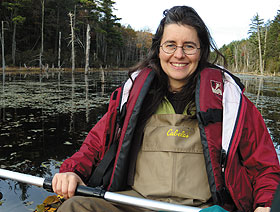  |
| HOME | THIS ISSUE | CALENDAR | GRANTS | BACK ISSUES | < BACK | NEXT > |
EPA grad fellowships help scientists develop research potential by Elizabeth Omara-Otunnu - December 1, 2008 | ||||
| When she’s not in the lab or the classroom, Denise Burchsted is probably out exploring the local streams and ponds. But she’s not playing hooky. Burchsted, a Ph.D. candidate with the Center for Integrative Geosciences in the College of Liberal Arts and Sciences, is developing a hypothesis about how the elimination and re-introduction of beavers has changed the New England landscape since precolonial times. Competitive award Burchsted is one of 13 UConn graduate students who have held STAR Fellowships since 1995. This highly competitive grant – in 2007, the year Burchsted won her grant, there were more than 3,000 applicants and only 69 awards – is worth up to $110,000. It provides up to three years of funding for Ph.D. candidates (two years for master’s degree students), and includes a $20,000 stipend, up to $12,000 for tuition and fees, and $5,000 expenses per year. Burchsted says the New England landscape changed significantly after the arrival of the colonists, yet little is known about the pre-colonial landscape. “All the things the colonists did still leave a very heavy signature on our landscape,” says Burchsted. “We don’t know what the rivers used to look like before Europeans came here. There are no maps, no records, just some scattered information.” In addition to the impact of humans through the clearing of forests for agriculture and building of roads and dams, the elimination of beavers by the mid-1800’s through trapping also had a considerable effect on area waterways. “Beavers build dams, and eventually, the dams fail and create meadows behind them,” says Burchsted, who holds a degree in civil engineering from UConn and has worked as a consultant in the field of river restoration engineering. “It’s different from how human dams change the shape of a river. Beaver dams are made of sticks so they leak, whereas human dams are made to be tight.” By studying precisely how re-introduced beaver activity affects the landscape, she hopes to develop a clearer picture of what forested waterways looked like and how they functioned in the past. Burchsted says the STAR fellowship enabled her to focus more sharply on her research. “I needed to invest more time in my work, and the fellowship provided the finances to make that happen,” she says. It also helped her attract funds from other sources, including a small grant from the Geological Society of America, and one from the University.
“There are also certain intangible results,” adds Burchsted, who hopes to make a career in academia. “The fellowship helps my work gain recognition and respect and will help in searching for an academic job.” A degree of latitude She began her graduate studies as a master’s degree candidate at the University of Maryland, and applied for the fellowship from there. But when her advisor, marine sciences professor Rob Mason, accepted a faculty post at UConn’s Avery Point campus, she transferred, bringing her two-year master’s degree fellowship with her. She has since switched into the Ph.D. program. Hollweg, whose research focuses on how mercury cycles in the ocean, specifically how it forms in sediment and accumulates in the food chain, says the fellowship was a boon. “The fellowship gave me a lot of freedom,” she says. “I didn’t have to be a teaching assistant or research assistant, I could dedicate all my time to my project.” And although her initial application was tailored to her advisor’s NSF grant, the fellowship gave her some latitude in shaping her own research. “I was able to go in my own direction, and not totally follow my advisor’s project,” she says. “I could try other things I was interested in.” Hollweg, who plans to pursue a career in environmental outreach or monitoring for government or a non-profit agency, hopes that when the time comes, the fellowship will help in the job search. “It shows my ability to bring money in,” she says. “It’s a pretty competitive fellowship.” Highly motivated Burchsted says there’s no need. “Since I want to be a scientist, it’s in my best interests to produce,” she says. “We’re a self-selecting group. We’re very motivated. The fellowship is really a way of getting scientists started.” |
| ADVANCE HOME UCONN HOME |

